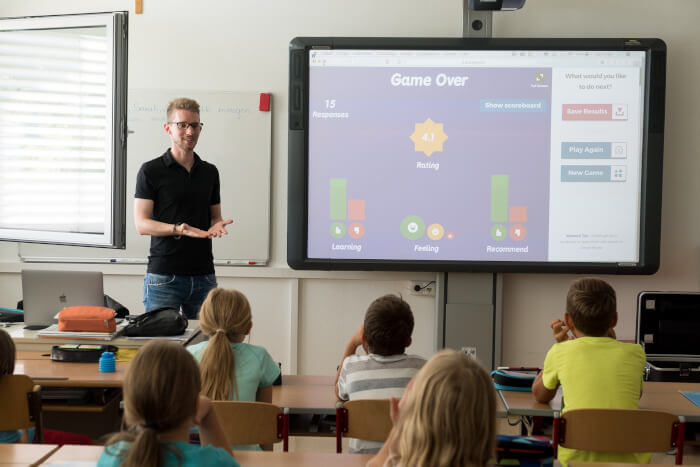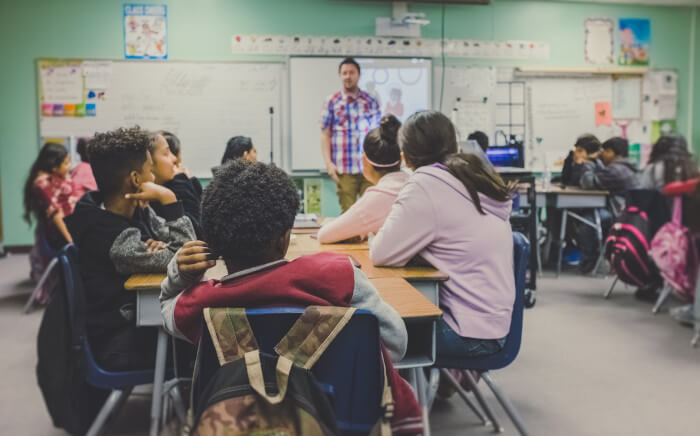As someone born in the 80s, I can hardly remember a time before computers. I vividly remember the day my dad brought our first computer home — it was big and white, and my older sister and I learned to input the designated codes in the designated order to access our favorite games. So I guess you could say my dad was one of the computer pioneers in our small town!
Since that time, computer technology has expanded in leaps and bounds. No longer does computer use in high schools merely entail ushering kids into the computer lab for the opportunity to play “Oregon Trail”, “Trucker”, and “Where in the World is Carmen Sandiego”. Instead, computers can now be
With that in mind, let’s take a look at how you can make the most of technology in your classroom.
Planning your lessons
Computers save time and help you organize material more easily when it comes to lesson planning. There are also lesson-planning apps and websites you can use to make your life much easier when typing up and organizing your lessons.
You can also search the web for existing ideas that you can adapt and use to integrate technology into your own classroom.
Check out Classcraft’s Marketplace for pre-made interactive Quests.
Technology-enhanced lesson planning
Many schools now have a way for teachers to connect their computers to a projector. Some even have SMART boards, Kindles, and personalized student computers. If you have access to any of these, or are able to schedule class time in a computer lab, here are eight ways you can use this technology to enhance your lessons and two ways computers can assist you beyond them.

1. Lesson organization
Computers help you better organize and present your information. Typing up your notes in Microsoft Word or Google Docs, or creating a PowerPoint presentation, helps you focus less on how you’re going to teach and more on what you’re going to cover. During class, you can project those notes onto a big screen to give students an indication of where the lesson is going. If you do have a tendency to take rabbit trails, or if your class is especially proficient at finding them, it’s easy to refocus and redirect when the lesson content is neatly organized on screen.
Having the notes projected onto a big screen also helps you focus on the overall content instead of getting lost in the minutiae. Rather than taking the time to write everything up on the board with a marker while you’re giving the lesson (and simultaneously having to worry about your handwriting and spelling), you can instead focus on expounding the content.

2. Visual aids
I’m a very visual learner, so when I teach, I like to use as many visual aids as I can. If I’m teaching about weather, for example, I want to not only talk about the subject but also show my students relevant pictures so they can better understand the topic. Fortunately, the Internet provides more opportunities than ever to find relevant images so you can give students a concrete context for the subject. Pre-selected images can also be projected or shown on individual computers to reinforce the lesson while you talk. At the very least, you can print pictures off of a personal computer and show them to the class.

3. Videos
A short, entertaining, instructional video is a great way to get students excited about learning. Some of my favorite sites for this are Brainpop, National Geographic Kids, and National Geographic on YouTube (especially the 101 videos like Tornadoes 101). Your students are also bound to love the Crash Course series with Hank Green; you can use these videos to quickly introduce a subject, supplement your own lessons, or review the material before an exam.

4. Class reading
I used to teach as a substitute in one classroom in which there was a Kindle library that the teachers shared and used in their English classes. The students could adjust the size of the text and follow along as their classmates took turns reading. Besides using Kindles, you can also project the assigned text onto a big screen or use personal computers to direct the students to sites like Learning A-Z, which has leveled e-books and guided lessons.

5. Board work with a SMART board
I love SMART boards — with this technology, you can easily project your computer screen onto the board while still retaining the functionality of a traditional classroom whiteboard. This means that you can display any pictures, notes, or practice work from your computer and then write all over them as you discuss different elements of the lesson. Students love coming up and writing on this board, too; this makes practice work for subjects like math, grammar, and languages especially fun.
If you don’t have access to a SMART board but do have access to a computer and projector, you can achieve similar results by simply projecting the image from your computer onto a whiteboard.

6. Games
Educational games are a great way to reinforce your lesson and engage your students (read more about the lessons that come from playing games). Students can play pre-selected games on individual computers, or you can project one game onto your board and play it as a class.
For example, Classcraft offers both pre-made and make-your-own quests that can be used to guide students through a particular lesson or unit. To make these quests even more engaging, you can include an accompanying online game or short video. Other websites with educational games include Sheppard Software, Fun Brain, PBS Kids Games, and National Geographic Kids Games.

7. Research
While I love hard-copy books, there’s no denying that the Internet has expanded the range of available resources and made research easier than ever before — students no longer have to trudge on over to the library and find books on their research topic, then flip through hundreds of pages to find what they’re looking for. Now, computers enable students to quickly and easily collect information from a wide range of credible online resources. Students can also use local library web pages to more efficiently search for relevant hard-copy sources.
Note: As we all know, not everything you read on the Internet is accurate. Be sure to discuss this with your students and maybe even give them a list of pre-selected sites that you trust. Alternatively, you can teach them how to distinguish between credible and untrustworthy sites.

8. Presentations
When it comes to presentations, computers provide a fun variety of ways for students to share their knowledge. PowerPoint is definitely a favorite that can be used with all ages. Students can write a story, display graphs and pictures, and practice public speaking as they navigate through the slides in an oral presentation. Prezi is another excellent online presentation resource for students; it gives them a bit more freedom and creativity in how they choose to present the information and transition between “slides.”
Students can also present what they’ve learned by using tools such as Microsoft Publisher to create bookmarks, brochures, posters, or postcards. There are even programs to guide students through the process of developing and designing their own websites. And of course, computers also enable students to type up high-quality reports, with the added benefit of helping them learn from editing features that check for spelling and grammar errors, as well as other writing mistakes.
Beyond the lesson
The role of a teacher continues long after the lesson has ended. To that end, here are two ways in which computers can enrich the post-lesson experience.
9. Communication and feedback
Some schools provide online portals like Canvas through which teachers and students can communicate via messages or discussion boards. This encourages questions and dialogue about classroom assignments. It also enables teachers to give immediate feedback on any project or assignment.
Did you know?
Classcraft offers a messaging feature that allows you to communicate with students and parents who have created parent accounts. You can also send announcements as one-way messages that blast out to all students or parents. Learn more about this feature here.
10. Grades
Rather than recording grades on individual papers and in a gradebook, and then sending out paper report cards at the end of each term, teachers can post the grades in an online portal that’s accessible to both students and parents. This allows everyone to get an immediate idea of how the student is doing. If the student is struggling with a concept, the parent is informed early enough to be able to work with the teacher on providing extra support. Plus, there’s less of a need to worry about any paper communication getting lost in backpacks and pockets.
Technology and learning go hand in hand
Computer technology has grown in leaps and bounds since the 80s. Whereas it was once a rare privilege to have access to computers, it’s now almost impossible not to (at the very least, there are libraries and internet cafes available to those who don’t own a personal computer). And while computers are not a necessary component of teaching (I’ve certainly taught without them), they do expand the possibilities available to you and your students. When used properly, classroom technology makes learning more fun, engaging, and highly effective.
Photo credit: Patricia Prudente / Unsplash.com
Classroom Management


